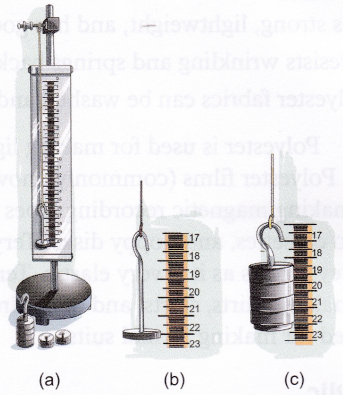What are the Advantages and Disadvantages of Synthetic Fibres
Advantages of Synthetic Fibres
Synthetic fibres have the following advantages.
- Most synthetic fibres have good elasticity.
- Most fabrics made of synthetic fibres do not wrinkle easily.
- Fabrics made of synthetic fibres are generally more durable, less expensive, and more readily available than those made of natural fibres.
- Most synthetic fibres can handle heavy loads without breaking.
Activity
Aim: To compare the strength of different fibres
Materials needed: Weight box with different weights (1-100 g), iron stand with damp, hook or pan, thin threads of nylon, wool, cotton, and silk (of same length and almost equal thickness)
Method:
1. Tie one end of the nylon thread to a hook or pan and the other end to the clamp (figure a).
2. Put a small weight on the hook/pan (figure b).
3. Keep on increasing the weight till the thread breaks (figure c). Note the total weight required to break the thread.

4. Repeat the procedure with the other threads.
Observation: More weight is required to break the nylon thread as compared to the others.
Conclusion: The thread that breaks at the maximum weight (nylon) is the strongest.
People also ask
- What are Synthetic Fibres and give some Examples
- Is Polyester Synthetic or Artificial
- What is the most common type of plastic?
- How polymers are classified?
- Justify the uses of synthetic polymers in daily life
Disadvantages of Synthetic Fibres
Synthetic fibres have the following disadvantages.
- Most fabrics made from synthetic fibres require careful ironing as they melt easily.
- Most fabrics made from synthetic fibres absorb very little moisture. They become sticky when the body sweats, which makes them uncomfortable to wear in hot weather.
- Most fabrics made from synthetic fibres catch fire very easily. Therefore, it is dangerous to wear them near a source of fire (e.g., while working in the kitchen).
Activity
Aim: To compare the water-absorbing capacity of fabrics made from natural and synthetic fibres Materials needed: Two cloth pieces of equal size (one made of cotton and the other of nylon) and two beakers/mugs containing equal amounts of water.
Method:
1. Soak each cloth piece in a different beaker/mug.
2. After 5 minutes, take out the cloth pieces and observe the water remaining in the beakers/ mugs.
Observation: More water is left in the beaker/mug in which the nylon cloth was soaked.
Conclusion: Nylon absorbs less water as compared to cotton.
